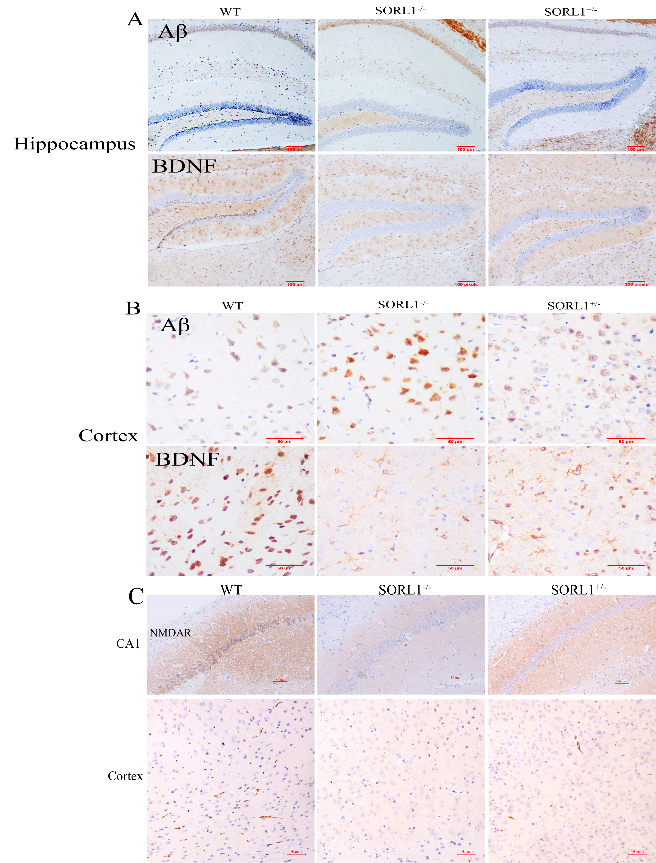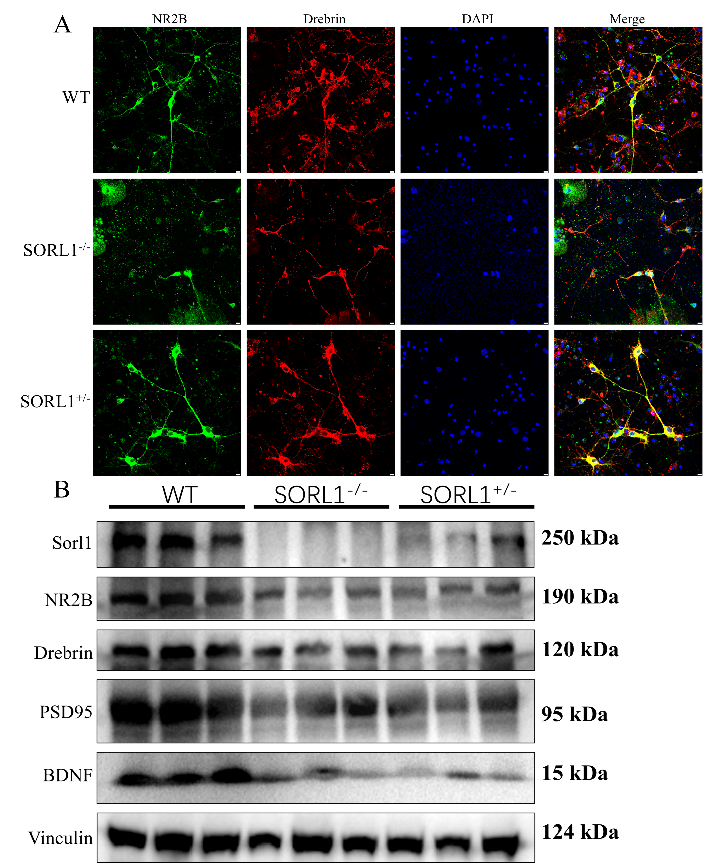NRR:中南大学侯德仁团队报道Sorl1基因参与迟发性阿尔茨海默病的发生
撰文:赵铭日,侯德仁
分拣蛋白相关受体1(sortilin-related receptor 1,Sorl1)基因是迟发性阿尔茨海默病高风险易感基因,可在迟发性阿尔茨海默病患者中显著低表达[1]。研究表明,SORL1主要存在于早期核内体和反式高尔基体中,可通过与不同的胞浆适配器相互作用,影响细胞内β-淀粉样前体蛋白转运和代谢,参与迟发性阿尔茨海默病的发生发展[2, 3]。此外,也有研究表明,在人诱导多能干细胞中敲除Sorl1基因会导致细胞内膜体增大,这是一种典型的阿尔茨海默病细胞病理学改变,且这种病理改变不能通过抑制β-分泌酶所改变[4]。这些研究提示Sorl1不仅可通过影响β-淀粉样前体蛋白代谢参与阿尔茨海默病的发生发展,还可能通过影响β-淀粉样前体蛋白、tau等相关蛋白在胞内的转运参与阿尔茨海默病的发展。既往研究表明,SORL1被敲除后,脑源性神经营养因子可减少β-淀粉样蛋白沉积的功能减弱,并失去了改善小鼠认知行为障碍的功能,这提示了脑源性神经营养因子改善小鼠认知和行为障碍的功能依赖于SORL1。目前尚不无这方面的报导,深入了解SORL1对脑源性神经营养因子等相关蛋白的调控作用,可以更好了解Sorl1导致迟发性阿尔茨海默病的致病原因。
最近中国中南大学湘雅三医院侯德仁教授团队联合中南大学生命科学院刘慕君教授团队在《中国神经再生研究(英文版)》(Neural Regeneration Research)上发表了题为“Sorl1 knockout inhibits expression of brain-derived neurotrophic factor: involvement in the development of late-onset Alzheimer’s disease”的研究,研究发现,Sorl1敲除导致 N-甲基-D-天冬氨酸受体表达分布异常,脑源性神经营养因子和突触相关蛋白表达减少,SORL1通过调控 N-甲基-D-天冬氨酸受体-环磷腺苷效应元件结合蛋白(CREB)-脑源性神经营养因子信号轴参与迟发性阿尔茨海默病发生发展。
Sorl1是迟发性阿尔茨海默病的高风险易感基因,在迟发性阿尔茨海默病患者中显著低表达。研究表明SORL1可能通过影响β-淀粉样前体蛋白、tau以外的其他相关蛋白在胞内的转运参与阿尔茨海默病的发生发展。侯德仁和刘慕君等发现SORL1敲除小鼠具有明显学习记忆异常(图1)。通过组织免疫组化可在小鼠海马和皮质存在β-淀粉样蛋白淀粉样沉积,且脑源性神经营养因子和 N-甲基-D-天冬氨酸受体表达减少(图2)。免疫印迹检测发现,海马中 N-甲基-D-天冬氨酸受体、脑源性神经营养因子等蛋白表达降低,且在体外培养的神经元细胞中可见突触形态异常;组织蛋白结果表明,SORL1敲除还会影响脑源性神经营养因子、N-甲基-D-天冬氨酸受体及突触相关蛋白的表达(图3)。这些结果揭示了Sorl1可通过调控 N-甲基-D-天冬氨酸受体-CREB-脑源性神经营养因子信号轴参与阿尔茨海默病的发生发展。

图1 Sorl1基因敲除小鼠具有明显学习记忆异常(图源:Zhao et al., Neural Regen Res, 2024)

图2 Sorl1基因敲除小鼠海马、皮质区可见β-淀粉样蛋白淀粉样沉积、脑源性神经营养因子和N-甲基-D-天冬氨酸受体表达减少(图源:Zhao et al., Neural Regen Res, 2024)

图3 Sorl1基因敲除小鼠海马神经元形态异常(A),N-甲基-D-天冬氨酸受体、脑源性神经营养因子和突触相关蛋白表达减少(B)(图源:Zhao et al., Neural Regen Res, 2024)
综上所述,Sorl1参与迟发性阿尔茨海默病的发生发展是多途径的,除了经典的影响β-淀粉样前体蛋白转运和代谢外,对 N-甲基-D-天冬氨酸受体-CREB-脑源性神经营养因子信号轴的调控也是其参与迟发性阿尔茨海默病发生发展的重要机制。在现今提及的给予脑源性神经营养因子治疗阿尔茨海默病时,应该关注患者是否具有Sorl1基因突变以及表达水平情况,在SORL1缺乏时,脑源性神经营养因子治疗可能是无效的。同时,文章没有很好的解释SORL1是如何调控 N-甲基-D-天冬氨酸受体的转运和分布以及如何影响脑源性神经营养因子的表达转运和代谢的,SORL1对 N-甲基-D-天冬氨酸受体在突触/突触外以及胞内的表达分布的区分没有十分明确,这需要更进一步且更为细致的研究。其次未进一步设计干预和挽救实验,未来可针对SORL1、脑源性神经营养因子和 N-甲基-D-天冬氨酸受体的干预进行进一步的研究,观察这些干预能否挽救小鼠学习记忆异常的表型,为临床阿尔茨海默病治疗提供参考。此外,该研究采用的体内外研究模型种属皆为小鼠,可在人多种神经细胞模型开展实验验证和研究。
原文链接:https://doi.org/10.4103/1673-5374.387975
参考文献
[1] Campion D, Charbonnier C, Nicolas G. SORL1 genetic variants and Alzheimer disease risk: a literature review and meta-analysis of sequencing data. Acta Neuropathol. 2019;138(2):173-186.
[2] Mishra S, Knupp A, Szabo MP, et al. The Alzheimer's gene SORL1 is a regulator of endosomal traffic and recycling in human neurons. Cell Mol Life Sci. 2022;79(3):162.
[3] Caglayan S, Takagi-Niidome S, Liao F, et al. Lysosomal sorting of amyloid-β by the SORLA receptor is impaired by a familial Alzheimer's disease mutation. Sci Transl Med. 2014;6(223):223ra220.
[4] Knupp A, Mishra S, Martinez R, et al. Depletion of the AD risk gene SORL1 selectively impairs neuronal endosomal traffic independent of amyloidogenic APP processing. Cell Rep. 2020;31(9):107719.
赵铭日和陈寻为论文共同第一作者,侯德仁教授和刘慕君教授为论文通讯作者。




